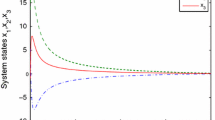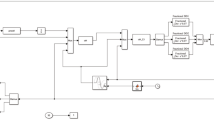Abstract
In this paper, a new fractional order exponential type reaching law (FOE-RL) is presented for the uncertain discrete-time system. The FOE-RL is constructed by adopting the exponential term and the Grünwald-Letnikov fractional order (FO) calculus of the switching function and the sign function. Compared to the integer order reaching laws (IO-RLs), the proposed reaching law is capable of regulating the system trajectory converging to a specified band whose width can be smaller than the upper bound of change rate of the disturbance and even approach zero. Hence, the proposed method has the ability to further suppress chattering and enhance the control accuracy compared to other reaching law strategies. The decrement band and the quasi-sliding mode domain (QSMD) of the uncertain system are analyzed. The sliding surface can be reached in finite steps, even though the system is suffering from uncertainties and disturbances. Numerical simulation examples are given to testify the validity of the presented method.
Similar content being viewed by others
References
S. Mobayen, “Adaptive global terminal sliding mode control scheme with improved dynamic surface for uncertain nonlinear systems,” Int. J. Control Autom. Syst., vol. 16, no. 4, pp. 1692–1700, Aug. 2018.
C. Mnasri, D. Chorfi, and M. Gasmi, “Robust integral sliding mode control of uncertain networked control systems with multiple data packet losses,” Int. J. Control Autom. Syst., vol. 16, no. 5, pp. 2093–2102, Oct. 2018.
Y. Liu, “Sliding mode control for a class of uncertain discrete switched systems,” Int. J. Control Autom. Syst., vol. 16, no. 4, pp. 1716–1723, Aug. 2018.
Y. Wu, H. Shen, H. R. Karimi, and D. Duan, “Dissipativety-based fuzzy integral sliding mode control of continuous-time T-S fuzzy systems,” IEEE Trans. Fuzzy Syst., vol. 26, no. 3, pp. 1164–1176, Jun. 2018.
Y. Wu, H. R. Karimi, H. Shen, Z. Fang, and M. Liu, “Fuzzy-model-based sliding mode control of nonlinear descriptor systems,” IEEE Trans. Cybern., vol. 49, no. 9, pp. 3409–3419, Jun. 2018.
M. Pai, “Robust tracking and model following of uncertain dynamic systems via discrete-time integral sliding mode control,” Int. J. Control Autom. Syst., vol. 7, no. 3, pp. 381–387, Jun. 2009.
K. Furuta, “Sliding mode control of a discrete system,” Syst. Control Lett., vol. 14, pp. 144–152, Feb. 1990.
W. Gao and J. C. Hung, “Variable structure control of nonlinear systems: A new approach,” IEEE Trans. Ind. Electron., vol. 40, no. 1, pp. 45–55, Feb. 1993.
W. Gao, Y. Wang, and A. Homaifa, “Discrete-time variable structure control systems,” IEEE Trans. Ind. Electron., vol. 42, no. 2, pp. 117–122, Apr. 1995.
X. Yu, B. Wang, and X. Li., “Computer-controlled variable structure systems: The state-of-the-art,” IEEE Trans. Ind. Inf., vol. 8, no. 2, pp. 197–205, May 2012.
P. Latosiski, “Sliding mode control based on the reaching law approach- a brief survey,” in Int. Conf. Methods Models Autom. Robot. (MMAR), Miedzyzdroje, Poland, pp. 519–524, 2017.
B. Jiang, H. R. Karimi, Y. Kao, and C. Gao, “A novel robust fuzzy integral sliding mode control for nonlinear semimarkovian jump T-S fuzzy systems,” IEEE Trans. Fuzzy Syst., vol. 26, no. 6, pp. 3594–3604, Dec. 2018.
A. Bartoszewicz, “Discrete-time quasi-sliding-mode control strategies,” IEEE Trans. Ind. Electron., vol. 45, no. 4, pp. 633–637, Apr. 1998.
A. Bartoszewicz and P. Leśniewski, “Reaching law approach to the sliding mode control of periodic review inventory systems,” IEEE Trans. Autom. Sci. Eng., vol. 11, no. 3, pp. 810–817, Jun. 2014.
A. Bartoszewicz and P. Leśniewski, “New switching and nonswitching type reaching laws for SMC of discrete time system,” IEEE Trans. Control Syst. Technol., vol. 24, no. 3, pp. 670–677, Mar. 2016.
A. Bartoszewicz and P. Latosiński, “Discrete time sliding mode control with reduced switching - a new reaching law approach,” Int. J. Robust Nonlinear Control, vol. 26, no. 1, pp. 47–68, Jan. 2016.
G. Bartolini, A. Ferrara, and V. Utkin, “Adaptive sliding mode control in discrete-time systems,” Automatica, vol. 31, no. 5, pp. 769–773, Apr. 1995.
H. Ma, J. Wu, and Z. Xiong, “A novel exponential reaching law of discrete-time sliding-mode control,” IEEE Trans. Ind. Electron., vol. 64, no. 5, pp. 3840–3850, May 2017.
Y. Niu, D. W. C. Ho, and Z. Wang, “Improved sliding mode control for discrete-time systems via reaching law,” IET Control Theory Appl., vol. 4, no. 11, pp. 2245–2251, Nov. 2010.
H. Ma, J. Wu, and Z. Xiong, “Discrete-time sliding-mode control with improved quasi-sliding-mode domain,” IEEE Trans. Ind. Electron., vol. 63, no. 10, pp. 6292–6304, Oct. 2016.
H. Du, X. Yu, M. Chen, and S. Li, “Chattering-free discrete-time sliding mode control,” Automatica, vol. 68, no. 3, pp. 87–91, Jun. 2016.
S. Chakrabarty and B. Bandyopadhyay, “A generalized reaching law for discrete time sliding mode control,” Automatica, vol. 52, no. 3, pp. 83–86, Feb. 2015.
S. Chakrabarty and B. Bandyopadhyay, “A generalized reaching law with different convergence rates,” Automatica, vol. 63, no. 3, pp. 34–37, Jan. 2016.
S. C. Qu, X. H. Xia, and J. F. Zhang, “Dynamics of discrete-time sliding-mode-control uncertain systems with a disturbance compensator,” IEEE Trans. Ind. Electron., vol. 61, no. 7, pp. 3502–3510, Jul. 2014.
Y. S. Eun, J. H. Kim, K. S. Kim, and D. Cho, “Discrete-time variable structure controller with a decoupled disturbance compensator and its application to a CNC servomechanism,” IEEE Trans. Control Syst. Technol., vol. 7, no. 4, pp. 414–423, Jul. 1999.
H. Ma and Y. Li, “Multi-power reaching law based discrete-time sliding mode control,” IEEE Access, vol. 7, pp. 49822–49829, Mar. 2019.
H. Ma, Y. Li, and Z. Xiong, “Discrete-time sliding-mode control with enhanced power reaching law,” IEEE Trans. Ind. Electron., vol. 66, no. 6, pp. 4629–4638, Aug. 2018.
C. Ma and H. Hori, “Fractional-order control: theory and application in motion control,” IEEE Ind. Electron. Mag., vol. 1, no. 4, pp. 6–16, Win. 2007.
Y. Wang, L. Gu, Y. Xu, and X. Cao, “Practical tracking control of robot manipulators with continuous fractional-order nonsingular terminal sliding mode,” IEEE Trans. Ind. Electron., vol. 63, no. 10, pp. 6194–6204, Oct. 2016.
Y. Chen, Y. Wei, and Y. Wang, “On 2 types of robust reaching laws,” Int. J. Robust Nonlinear Control, vol. 28, no. 6, pp. 2651–2667, Apr. 2018.
P. Muthukumar, P. Balasubramaniam, and K. Ratnavelu, “Sliding mode control for generalized robust synchronization of mismatched fractional order dynamical systems and its application to secure transmission of voice,” ISA Trans., vol. 82, pp.51–61, Nov. 2018.
Q. Xu and Y. Li, “Micro-/nanopositioning using model predictive output integral discrete sliding mode control,” IEEE Trans. Ind. Electron., vol. 59, no. 2, pp. 1161–1170, Feb. 2012.
K. Abidi, J. X. Xu, and X. Yu, “On the discrete-time integral sliding mode control,” IEEE Trans. Autom. Control, vol. 52, no. 4, pp. 709–715, Apr. 2007.
S. Chakrabarty and B. Bandyopadhyay, “Minimum ultimate band design of discrete sliding mode control,” Asian J. Control, vol. 18, no. 1, pp. 1–9, Sep. 2015.
S. Kamal, A. Raman, and B. Bandyopadhyay, “Finite-time stabilization of fractional order uncertain chain of integrator: an integral sliding mode approach,” IEEE Trans. Autom. Control, vol. 58, no. 6, pp. 1597–1602, Jun. 2013.
I. Podlubny, Fractional Differential Equations, Academic, New York, NY, USA, 1999.
G. Sun, L. Wu, Z. Kuang, Z. Ma, and J. Liu, “Practical tracking control of linear motor via fractional-order sliding mode,” Automatica, vol. 94, pp. 221–235, Aug. 2018.
S. Fan, “A new extracting formula and a new distinguishing means on the one variable cubic equation,” Natural Science J. Hainan Teachers College, vol. 2, no. 2, pp. 91–98, 1989.
X. Yan, J. Xu, Y. Zhu, J. Wang, Y. Yang, and C. Wang, “Downlink average rate and SINR distribution in cellular networks,” IEEE Trans. Commun., vol. 64, no. 2, pp. 847–862, Feb. 2016.
X. Wu, Y. Tang, and J. Cao, “Input-to-State stability of time varying switched systems with time-delays,” IEEE Trans. Autom. Control, vol. 64, no. 6, pp. 2537–2544, Jun. 2019.
X. Wu, P. Shi, Y. Tang, and W. Zhang, “Input-to-state stability of nonlinear stochastic time-varying systems with impulsive effects,” Int. J. Robust Nonlinear Control, vol. 27, no. 10, pp. 1792–1809, Jul. 2017.
X. Wu, Y. Tang, and W. Zhang, “Input-to-state stability of impulsive stochastic delayed systems under linear assumptions,” Automatica, vol. 66, pp. 195–204, Apr. 2016.
C. Yin, Y. Chen, and S. Zhong, “Fractional-order sliding mode based extremum seeking control of a class of nonlinear systems,” Automatica, vol. 50, no. 12, pp. 3173–3181, Dec. 2014.
Author information
Authors and Affiliations
Corresponding author
Additional information
Publisher’s Note Springer Nature remains neutral with regard to jurisdictional claims in published maps and institutional affiliations.
Recommended by Editor Hamid Reza Karimi. This work is supported by the National Science Foundation of China under Grant (51805327, 51575544), by the Hong Kong Scholars Program under Grant (XJ2017022), the research committee of the Hong Kong Polytechnic University under Grant (G-YZ1G, 1-ZE97), and in part by Tianjin Natural Science Foundation (16JCZDJC38000).
Haifeng Ma received his B.E. and M.E. degrees in mechanical engineering from Southwest Jiaotong University, Chengdu, China, in 2010 and 2013, respectively, and his Ph.D. degree in mechatronics from Shanghai Jiao Tong University, Shanghai, China, in 2017. He is currently working at the Key Laboratory of High Efficiency and Clean Mechanical Manufacture of MOE, School of Mechanical Engineering, Shandong University, Jinan, China. He is also a “Hong Kong Scholar” and a postdoctoral fellow in The Hong Kong Polytechnic University, Kowloon, Hong Kong, China. His research interests include sliding-mode control (SMC) theory and applications, vibration control and intelligent manufacturing.
Yangmin Li received his B.S. and M.S. degrees from Jilin University, Changchun, China, in 1985 and 1988, respectively, and his Ph.D. degree from Tianjin University, Tianjin, China, in 1994, all in mechanical engineering. He is currently a Full Professor of the Department of Industrial and Systems Engineering of The Hong Kong Polytechnic University. He has authored and coauthored 420 scientific papers in journals and conferences. His research interests include micro/nanomanipulation, compliant mechanism, precision engineering, robotics, multibody dynamics and control. Dr. Li is a Member of the ASME. He is an Associate Editor of the IEEE Trans. Auto. Sci. Eng., Associate Editor of Mechatronics, Associate Editor of the International Journal of Control, Automation, and Systems, and Associate Editor of IEEE Access.
Rights and permissions
About this article
Cite this article
Ma, H., Li, Y. Fractional Order Exponential Type Discrete-time Sliding Mode Control. Int. J. Control Autom. Syst. 18, 374–383 (2020). https://doi.org/10.1007/s12555-018-0898-8
Received:
Revised:
Accepted:
Published:
Issue Date:
DOI: https://doi.org/10.1007/s12555-018-0898-8




